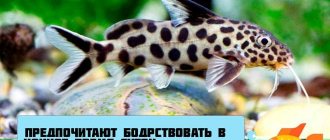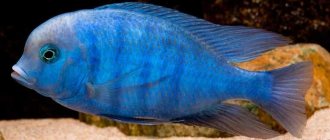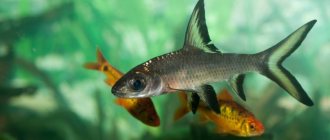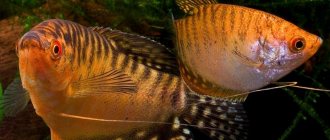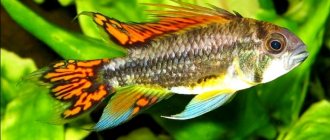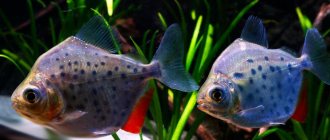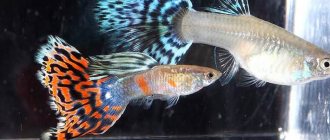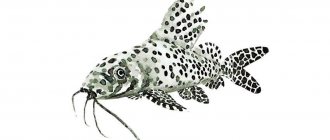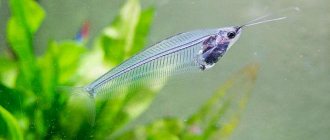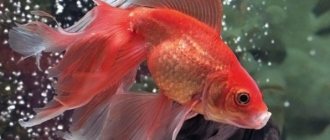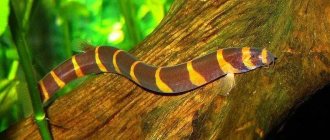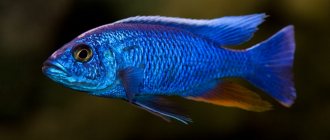Few aquarists know that Aulonocara multicolor, which belongs to the Cichlid family, is a fish that requires careful care. She has an attractive appearance and increased endurance. However, not only is the fish a predator, but it also requires the creation of special conditions of detention. And yet, knowing that she will grow up to be quite a large and beautiful individual, aquarists give preference to her.
Description
Aulonocara multicolor has the following external characteristics:
- variegated color (yellow-orange body covered with spots of blue-blue shades);
- the body is oval-shaped, flattened on the sides;
- the presence of a large pointed fin on the back;
- body length reaching 15 centimeters.
Inexperienced aquarists wonder how long individuals live. In properly created conditions, their life expectancy can reach 8 years.
Maintenance and care
Aquarium fish are quite demanding creatures. So that it does not get sick, develops properly, and reproduces, it is important to observe the basic conditions when arranging the aquarium. Water parameters should be as follows:
- temperature – 24-27°C;
- hardness – from 8 to 16 units;
- acidity (pH) – from 7 to 8 units.
It is important to remember that the water should always be clean and fresh. For this reason, aquarists recommend equipping a fish tank with a filter and even a compressor so that your pets have enough air. It is necessary to replace the water mass by at least a quarter weekly. The capacity of the tank for one fish should not be less than 80 liters, but if there are 5-6 of them - at least 200 liters.
Cichlids do not like bright lighting, so it is better to purchase lamps that provide diffused light. An excellent soil option is crushed pebbles, coarse sand, the layer of which should be at least 5 cm. Some people prefer crumbs made from corals. As for the placement of plants, they do not necessarily have to be present.
Typically, aulonocaras prefer space, a lot of free space. However, the presence of a small number of plants such as Anubias, Echinodorus, Nymphea will not hurt them. There should also not be a lot of decorative elements in the aquarium. It is advisable that enough substrate be left for the fish, unoccupied by plants and decorations. This way they can move freely around the aquarium.
Mr. Tail recommends: variety of Aulonocara species
This fish is often kept in aquariums, which has contributed to the breeding of various hybrids. At the same time, it should be noted that the varieties found in nature also differ in color and shape. Here are the characteristics of some of them.
Nyasa or Queen Nyasa
One of the brightest and most popular varieties in the aquarium hobby.
There are males of colorful, yellow, sky and even coral colors. The most common species with a dark olive body, blue fins and a wide red stripe. For this reason it is called the Red-Shouldered Peacock. During the spawning period, the color of males becomes most expressive. Females are modest, gray-brown with black side stripes.
This is endemic to the underwater laboratory of Malawi; it is impossible to see this fish in other bodies of water in nature. They prefer clean water and the ability to move freely. In the aquarium they recognize and greet their owner when approaching. They communicate with each other using characteristic movements and sounds.
They like to search for living creatures by filtering the soil, so a large bottom area is preferable. There are approximately 50 liters per individual. Based on this, there is no need to choose a tall aquarium, but rather a long and wide one. It is advisable to keep a male and several females together. On this natural basis, the following morphs were obtained: marbled, albino, blue neon.
Bensha (Hansbensch)
Named after Dr. Ulrich Bensch, founder of Tetra. Its other name is also known - the Golden Queen, received for the sunny color of the body with bluish stripes. The fins are blue with a white rim along the edge. Part of the head and mouth are painted bluish. The iris of the eyes has a yellow border. The average size of the fish is 13-15 cm.
The least aggressive species, hostility between males appears only during spawning. They treat neighbors calmly.
There is a subspecies of Benshi - Maleri, which is sometimes also called the sun or yellow peacock.
Stewartgranti Ngara
In addition to its scientific name, it is also known as Grant's Peacock or Royal Peacock. Males are painted in all known colors. Their greatest brightness appears by 2 years. Size 12-15 cm. Female representatives are inconspicuous, gray. Numerous morphs have been created based on the species:
- Multicolor. It has a bright color: spots of light or dark blue are randomly located on a golden or red background. This is the result of a long, painstaking selection process. They do not live in the natural environment. Body 15 cm. Dorsal fins: in males - sharp, in females - rounded, grayish.
- Orchid ed or Strawberry. Created based on several types. A small fish 10-13 cm with a large head, flattened body, and high back. Juveniles and females are grayish with an admixture of silver. Males are scarlet, golden, orange. They acquire their color by 10 months. Calm character. During spawning, 8 color combinations are obtained. To preserve the original appearance, it is better not to mix Strawberries with other representatives.
- Red Ruby. Body 12-15 cm. Females are light brown or red. Males are fiery colored with a blue head and white stripes.
- Rose. It got its name because of its predominantly pink shades. Length 12-15 cm. Body elongated, flattened on the sides. The mouth is small with narrow lips.
- Marmalade or Variegated. Small fish 5-7 cm in length. Interesting color, but among them there are also colorless ones.
In their natural environment they can live at a depth of 15-20 m, preferably the bottom is sandy with a pile of stones. During the breeding season, males are very active in protecting their territory.
Mailanda
The fish is a dark, cold blue color. It exists in two variations, distinguished by a wide large stripe on the back: white or yellow. Size 8-10 cm. The volume for home keeping is better than 100 liters, where a male and 3-4 females can live.
Maulana
Individuals are blue with a yellow stripe throughout the body. Length 10-15 cm. In the wild, it loves sandbanks with a depth of up to 5 m. Diet: small invertebrates at the bottom. In an aquarium, sand is desirable as a substrate and stone decorations. Lives up to 15 years.
Aurika
The name in Latin is Trematocranus or the commercially common Aulonocara or Jacobfreibergi Eureka. A representative of the rock species, which is characterized by a pattern of vertical stripes. The main background of males is blue, and there are red, yellow or orange pigments on the body, head and back. The fins are white at the ends. Size 8-13 cm.
Red Dragon
You can find other names for this hybrid: Dragon's Blood, Firefish or Strawberry. It was bred by crossing 3 species. The scales are painted bright red, closer to the tail they have a bluish tint. Length 13-15 cm.
Freiberg
Known colors range from gray-yellow to violet-orange. The presence of vertical noticeable dark stripes is mandatory. With good care, it grows up to 17 cm. The difference between this species is that the tail is deeply forked, and there are spiny rays in the back of the other fins.
Compatibility and behavior
Aulonokara has a fairly peaceful disposition, and therefore its behavior towards other fish species is non-aggressive. However, there are certain types of individuals with which it is better not to populate them in the same tank. These include:
- pseudotropheus demasoni;
- Haplochromis cornflower;
- pseudotropheus lombardo;
- Melanochromis auratos;
- Cichlids of Lake Tanganyika.
In addition, you should not populate the described individual with related aggressor species. Aulonokara will only suffer from such a neighborhood. Good compatibility of individuals is observed with:
- catfish (ancistrus);
- labidochromis yellow;
- Copadichromis "Kadango";
- blue ackee;
- blue dolphin
When choosing neighbors for an aulonocare, it is important to take into account the peculiarities of preparing its diet at home, as well as the complexity of maintenance and care.
Feeding
It is a known fact that the described individuals are unpretentious in food. Any food is suitable, both granulated and in the form of flakes. Individuals will not disdain “live” food, for example, cyclops, brine shrimp, and coretra. Bloodworms should be given to them in moderation. Aquarists recommend enriching and giving preference to foods containing a certain amount of carotenoids, as this will help improve the red shades on the fish.
Some cichlid breeders recommend making your own food. To make it at home, you will need the following ingredients:
- raw squid meat (mussels, shrimp);
- scalded lettuce leaves;
- scalded spinach, pumpkin or zucchini;
- calendula petals (sold at the pharmacy);
- saffron;
- paprika.
All ingredients are ground and mixed. It is recommended to give the resulting mass a maximum of twice a day to avoid overfeeding aquatic pets. Feeding aulonocara involves alternating several types of food.
Reproduction and breeding
Breeding fish is possible both in a general aquarium and in a separate tank. It is important that the male is surrounded by several "girls" and that the scenery provides plenty of hiding places. This is necessary not so that the fish can “seclude themselves,” but so that the female can hide from the annoying advances of the male if she is not ready for them.
In addition, it is worth making sure that the male sees an open place in the substrate where he will prepare a hole for spawning. Flat stones are also suitable for these purposes. For fish reproduction to be successful, the temperature of the water masses must be at least 30°C. The female, who responded to the male’s advances, must lay eggs in the hole created by him. Then the future “dad” impregnates her.
The female takes the fertilized eggs into her mouth, where she keeps them for three weeks. In this way, aulonocara protect their offspring from being eaten by other fish.
Fry, caring for them
The hatched fry are moved to another tank. They are fed both dry and live food. The first few months of life, the young are distinguished by their inconspicuous color, which subsequently changes. The fry reach sexual maturity by one year.
What to feed
Aulonocara orchids are omnivorous. Animal food predominates in the diet. Plant food makes up 20–30%.
Live food
- Bloodworm is a mosquito larva. High-calorie, hemoglobin-rich, vitamin food.
- Koretra is a mosquito larva. Mobile dietary food. Forces fish to hunt.
- The tubifex is an annelid worm. Recommended for weakened and growing fish.
Do not purchase live food from unverified sellers. Fish caught in natural waters may be infected with infection, parasites, and contain harmful substances. The coretra is not so dangerous, since it lives and obtains food in the water column.
Frozen food
Fully preserves the usefulness of the living. It is not a carrier of parasitic and bacterial threats. But re-frozen is unsuitable for use. And this is impossible to control.
Dry food
They are not suitable for constant feeding: orchids lose color and stop reproducing. Helpful if you plan to be away for a long time. Use automatic feeders with a timer.
Goldfish coloring granules maintain color intensity. Ask 1-2 times a week.
Plant food
Purchased - tablets with spirulina. Dried and fresh herbs, nettle and dandelion leaves are suitable. Blanched zucchini, pumpkin, and cabbage are useful. From cereals - crushed oat flakes (“Hercules”).
Prepared feed
For high-quality color, aulonocara orchids require sufficient quantities of carotenoids (astaxanthin). It is found in significant quantities in red fish, carrots, and other red vegetables and fruits. Prepare and freeze minced meat containing the specified components with the addition of shrimp, squid, and mussels. Astaxanthin is also an antioxidant and improves metabolism and digestion.
Diseases, their prevention
The described representatives of the Cichlid family do not have a specific set of diseases inherent to them. In order for fish to avoid diseases, it is important to provide them with adequate living conditions. This is precisely what their prevention is all about.
Aulonocara multicolor is a beautiful, unusual aquarium fish, which is confirmed by its description. Inexperienced aquarists should not keep it, because it requires special care. However, if a person is confident in his own abilities, he can take risks. The main thing is to provide the fish with proper living conditions and food.
Arrangement of the reservoir
Choosing a suitable aquarium is quite simple. The volume for two orchids should be at least 80 liters, and for a small group - at least 250.
Aquaparameters. Water indicators must be maintained within the following limits:
- temperature: 23-28 °C;
- acidity: 7.4-8.5 pH;
- hardness: 10-30 °dH.
It is important to monitor the water quality, it must be good. A filter, regular aeration and 15-20% changes every week will help with this.
Lighting can be anything.
Bottom arrangement. It is better to put quartz or river sand at the bottom.
The soil should not have sharp particles, since the fish dig it and sift it through their gills.
It is recommended to place large smooth stones, grottoes, and clay pots on it. You can build caves and rocks out of them, which the aulonokars will use as shelters. It is not advisable to decorate an aquarium with sea corals, as the fish may get injured by them.
A good decorative option can be obtained using sandstone, the light stones of which not only resemble grottoes, but also make the water hard, which African cichlids love.
Plants are not required, but if the owner decides to plant them, then they need to be properly strengthened in the ground, since aulonocaras can dig them up. Suitable:
- nymphea,
- anubias,
- cryptocoryne,
- hygrophila,
- limnophila,
- Vallisneria.
